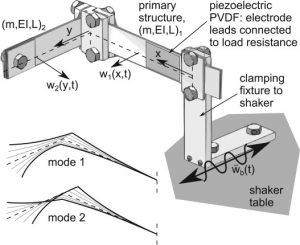Harvesting electrical power from vibrations or other mechanical stress is pretty easy. Turns out all it really takes is a bit of crystal or ceramic material and a couple of wires and, there you go, piezoelectricity. As stress is applied to the material, charge accumulates, which can then be shuttled away to do useful work. The classic example is an electric lighter, in which a spring-loaded hammer smacks a crystal, producing a spark.
We’re surrounded by this sort of ambient energy. The whole universe is just a big mess of force and stress. The tapping of my fingers on the keyboard now could theoretically be used to generate voltage. In fact, the idea is already under patent: a battery-charging keyboard cover. But the idea scales way up too: Imagine the sway of a skyscraper or the trembling of an entire forest in the wind.
The second example is the heart of a piezoelectric system described in a new paper in the Journal of Sound and Vibration courtesy of engineers at Ohio State’s Laboratory of Sound and Vibration Research. The basic idea behind the energy harvesting platform: exploit the natural internal resonances of trees within tiny artificial forests capable of generating enough voltage to power sensors and structural monitoring systems.
The piezoelectric power produced by the flexing of a tree in some wind isn’t quite on par with that produced by a proper windmill. Part of the problem is that a vibration-based piezoelectric energy harvesting scheme is necessarily limited in the frequency range of vibrations that it can usefully convert into power. Different ranges demand different material properties. Unfortunately for our energy needs, wind is a pretty random thing.
Image: Harne et al
What the Ohio State group, led by mechanical and aerospace engineering professor Ryan Harne, found is that it may be possible after all to convert relatively random range of vibration frequencies to useful energy by exploiting the natural resonant frequency of tree-like structures. This resonant frequency can be imagined as a kind of frequency wall or barrier that absorbs and stores the vibrational energies of the higher frequencies, sort of like how small riffles on the surface of a body of water get soaked up into larger swells.
The paper uses a foot-bridge metaphor for resonant frequency. Imagine a crowd of people stomping across a bridge. All of the walkers are stepping with different frequencies, but some match that of the resonant frequency of the bridge and so this larger, much lower frequency is amplified. The stepping frequencies might all average out, constituting something like white noise, but that’s not quite how it works here: Some of that stepping energy is captured by the bridge because of its resonance.
This is sort of how it goes in trees—a breeze might whip a leaf or small branch around like crazy, but that power is also being subsumed into the larger, much more powerful low-frequency sway of the tree itself.
Harne’s initial mathematical finding that it is indeed possible to capture useful energy from random or random-ish wind (“noisy” wind) input was then tested out using an actual tree-like L-shaped construction of small steel beams wrapped in polyvinylidene fluoride (PVDF), a piezoelectric material. They managed to produce about 2 V.
It’s mostly a proof of concept or rather a disproof of the assumption that wind vibrations can’t be usefully harvested. Don’t expect tiny metal forests to power cities, but it’s still a cool idea.
read more original article Motherboard

